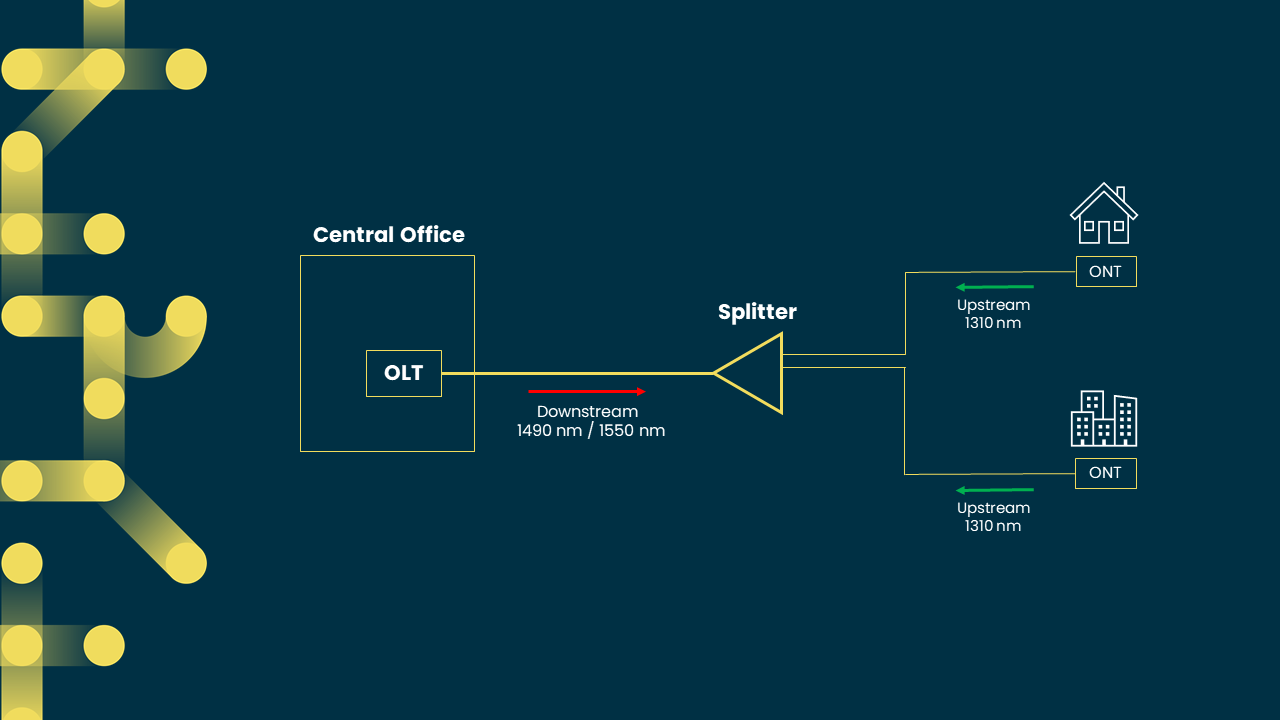Types of PON: A Quick Guide to Optical Networks

What is a PON?
PON stands for “Passive Optical Network” and, as the name says, are purely passive fiber optic access networks that allow broadband telecommunications between an OLT, located at a Telecom Operator’s Central Office, and several ONTs, located at the network user's premises.
The transmission of communications is done in a fiber optic network, whose division of the signal is done by a device that is purely passive, called optical splitter.
Optical fiber networks that use splitters are networks with a Point-Multipoint (P2MP) architecture. Optical fiber networks without splitters, whose optical path goes from the central office to the customer's premises without signal division, are networks with a Point-to-Point (P2P) architecture.
How does it work?
A PON is a fiber optic network, as mentioned above, where communication from the central office to the user (Downstream - DS) and communication from the user to the central office (Upstream-US) is carried out on a single fiber.
To achieve this type of communication on a single fiber, passing through splitters, two principles of multiplexing used in telecommunications are used: WDM (wavelength division multiplexing) for Downstream transmission, and TDM (Time division multiplexing) for Upstream communication.
WDM allows signals to travel along the fiber in both directions without creating interference, as the DS signal has one wavelength (1490nm) and the US signal has another wavelength (1310nm). The 1550nm wavelength can also be added for DS transmission, for services such as analog TV or others.
As there are several ONT's in the network and they all transmit at a wavelength of 1310nm, the OLT assigns a "time slot" to each ONT and it only transmits in its defined "time slot", allowing the communication to take place without interference or loss of data. information. Here comes the principle of TDM, as mentioned earlier.

Different types of PON:
APON
It was the first type of PON standard and was applied to business networks. Unlike Ethernet or Internet protocols, which use packets with variable sizes, APON uses packets with fixed sizes. APON stands for Asynchronous Transfer Mode PON.
BPON
It's a standard similar to APON but which introduced WDM technology, allowing the use of several wavelengths in a single fiber. BPON stands for Broadband PON.
EPON
This network uses Ethernet packets and uses the IP protocol for data transmission on the network. It operates with a symmetric 1GBps bandwidth (DS and US). EPON stands for Ethernet PON.
GPON
Is the evolution of previous versions, using various types of packet encapsulation, depending on the service. It offers bandwidths on the order of 2.5 GBps in Downstream and 1.25 GBps in Upstream. GPON stands for Gibabit PON.
To learn more about GPON, click here.
What are the benefits?
PON types are similar to each other since they are passive fiber optic networks. They are distinguished by different transmission speeds and information transmission capacity (bandwidth).
PON’s were initially designed to allow operators to reach their customers with more and better services. The great advantage of PON networks is the reduction in the number of fibers needed and the fact that they are purely passive networks, which eliminates the need for power sources to feed equipment, from the Central Office to the customer's premises.
What’s the value for companies?
PON networks are beginning to be seen by companies as something attractive, even for application in local area networks (LAN). Since PON uses optical fibers, which have a lifespan of over 25 years, as they are passive networks, it is able to reduce investment in equipment. The result - Reduction in energy consumption and a simplification and reduction of maintenance costs, as the passive network is much more stable.
Why is it changing the industry?
The telecommunications industry is guided by the continuous growth of information consumption, so fiber optic networks are the type of network that best manages this continuous need. With the technological evolution and with the introduction of 5G mobile networks, and the concept of “all connected, always connected”, fiber optic networks are a reality and not just a vision of the future.


